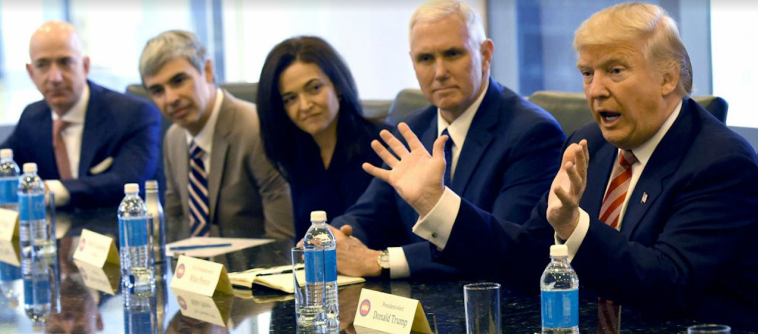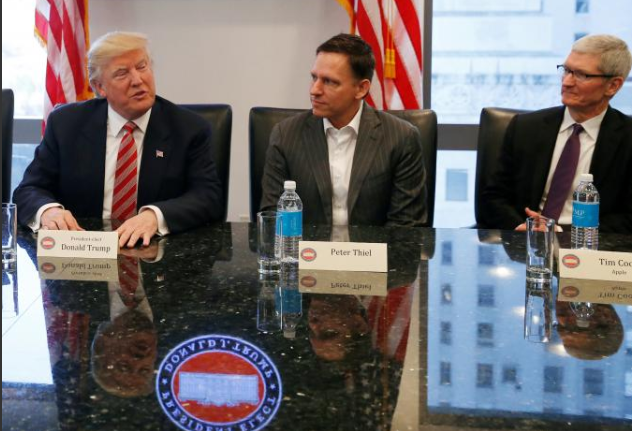 aNewDomain — Twitter CEO Jack Dorsey wasn’t among the tech titan honchos who showed up at US president elect Donald Trump’s tech symposium today at Trump Tower.
aNewDomain — Twitter CEO Jack Dorsey wasn’t among the tech titan honchos who showed up at US president elect Donald Trump’s tech symposium today at Trump Tower.
That’s because Trump bounced Twitter from the meeting, two sources close to the company told our reporters today. They confirmed a sourced report that appeared earlier this afternoon in Politico, which said the Trump camp is punishing the social network for a business deal that went awry during the campaign.
The Trump Twitter bitchslap happened, they said, because Twitter nixed two emoji images for the hashtag #CrookedHillary during the campaign. Dorsey refused the emojis, they added, because he wasn’t comfortable with the campaign’s accusing Hillary Clinton of a crime she wasn’t charged with or under investigation for.
We have calls out to Dorsey and the Trump transition team for official comment.
In the meantime, let’s think about this.
Set aside the impulse to figure out whether Twitter was right or wrong to strike the emojis. That’s irrelevant.
 The real issue is about how Trump and his cronies plan to treat Silicon Valley moving forward.
The real issue is about how Trump and his cronies plan to treat Silicon Valley moving forward.
That the Trump camp would trash Twitter for a business deal that went sideways during the campaign ought to seriously disturb all tech industry leaders.
It ought to scare the hell out of them.
Never mind the happy talk tech leaders will make around today’s tech meeting.
The message from Trump to tech is: Get in line, or watch your back.
Here’s what we know so far about what’s going on here, and what Silicon Valley should do next to preserve their autonomy and self respect under this incoming administration.
A $5 million dollar deal gone sideways?
The tale around what happened between Trump and Twitter regarding the emojis is pretty much told, at least from the Trump camp’s point of view.
In a long and somewhat whiny post on Medium in October, Trump campaign digital advertising and fundraising director Gary Coby accused Twitter’s Dorsey of personally blocking the organization’s efforts to run two #CrookedHillary emojis.
Wrote Coby:
“We had an upfront deal with Twitter, which is a common setup where we commit to spending a certain amount on advertising and in exchange receive discounts, perks and custom solutions.”
That upfront $5 million dollar deal, he said, was reached last summer. Its terms included discounts on Twitter trend promotions, bonus media on additional spending and, he claimed, “value adds, such as custom hashtag emojis.
The original deal involved promotions around the Republican Convention in late July, the first and second presidential debates and the Sunday before Election Day, he added.
 The promotional deal was approved by Twitter’s legal and policy departments, said Coby, but Dorsey later “restricted (the Trump campaign) on the most unique part of our deal, the custom hashtag emojis.”
The promotional deal was approved by Twitter’s legal and policy departments, said Coby, but Dorsey later “restricted (the Trump campaign) on the most unique part of our deal, the custom hashtag emojis.”
According to Coby’s account of what happened, Twitter at first approved the moneybag emoji (shown at left).
But when he met with Twitter execs in New York to “tweak” the image, as he put it, the emoji of choice morphed into a stick figure (shown below) running away with a bag of money.
That’s when the deal really began to sour.
“Sure, it was more aggressive and eye-catching, but that was the goal. I was fine with the hand/moneybag emoji, which was already approved, so I figured we might as well see if we can go further,” Coby wrote.
However, after some delays on the Twitter team’s part, Coby says he was notified by Twitter sales VP Dan Greene told him that not only was the stick figure not approved, but the company had pulled its approval of the original moneybag image, too.
 According to Coby, Greene told him Twitter was unwilling to accuse Hillary Clinton of a crime she didn’t commit or wasn’t under investigation for, implying the company feared a suit by Clinton if it did so.
According to Coby, Greene told him Twitter was unwilling to accuse Hillary Clinton of a crime she didn’t commit or wasn’t under investigation for, implying the company feared a suit by Clinton if it did so.
“We told them it was BS and what they were doing with a public platform was incredibly reckless and dangerous,” Coby said.
In early October, he added, Twitter chief Dorsey and COO Adam Bain explained to the Trump organization that the campaign “needed to pull the emoji because wasn’t a paid-for-by (election) disclaimer.”
Greene and Bain have as yet to return aNewDomain’s calls for comment on this exchange.
What’s next for Twitter?
How Twitter decides to deal with the Trump camp’s rejection of it as part of today’s tech roundtable will set the stage for how other tech companies will deal with inevitable Trump presidency demands of Silicon Valley.
For instance, Twitter stands out among tech companies bowing down to Trump of late. By bowing down, I’m referring to suckups like IBM CEO Ginny Rometty, who sent a fawning Nov. 14 letter to Trump, which personally pledged IBM’s availability to and support of the administration.
Scroll to the end of this post to read the letter in full. Ed.
According to a recent piece in The Intercept, Twitter was the only one among nine tech companies queried that went on the record saying it will play no role in helping Trump build his so-called registry of Muslim Americans.
Will it fold now?
We eagerly await Twitter’s response on this. Silicon Valley needs leaders in a political environment that so far appears to be about free speech and civil liberties, much less the freedom of tech firms to govern their companies as they see fit.
Sure, the Trump rejection has got to make Twitter more than a little sore. Today’s meeting included Amazon chief Jeff Bezos who, as the owner of The Washington Post, was a frequent critic of Trump during the campaign. Apple chief Tim Cook was there, too. Early in the campaign, Trump called for a boycott of Apple back in February because it refused to decrypt an accused terrorist’s smartphone.
Twitter should realize, too, that is not without bargaining chips here. The social platform is important to the Trump campaign. Trump has more than 17 million followers on Twitter.
Were Twitter to shutter that, which is its right, Trump would lose a valuable mouthpiece.
Today at the meeting, Trump told the tech CEOs he did allow to attend the meeting that, in the future, he was open to all communications. “Call me,” he reportedly told the tech chiefs. “We have no formal chain of command around here.”
Dorsey should pick up the horn at once. He shouldn’t be afraid to throw some of his own sizeable power around, either.
That is the only kind of reaction that Trump and his cronies will understand.
As for what Silicon Valley should do, that’s clear enough, too.
Forget bowing and scraping ala IBM CEO Rometty. I don’t care that she is now a member of Trump’s newly formed Strategic and Policy forum as a result of it.
Sucking up is in no one’s interest here.
The Valley should look at the Trump Twitter bitch slap for what it is — a warning shot. Tech leaders need to quickly develop a strong and coordinated line of defense, a coalition of sorts to keep Trump cronies from dividing, separating and otherwise forcing it to depart from its collective interests and those of their customers.
We are stronger than we know, of course. And, to borrow a political phrase, for sure we are stronger together.
History is watching.
For aNewDomain commentary, I’m Gina Smith.
Ed: Here is the letter IBM’s Rometty sent Trump, readable in full and in place, below.
IBM Letter to Trump by Gina Smith on Scribd
Cover image of Trump with Apple chief Tim Cook and other tech leaders: Shannon Stapleton, Reuters, All Rights Reserved.













